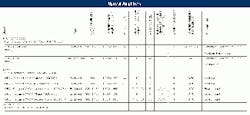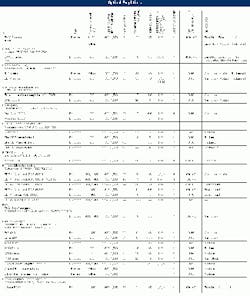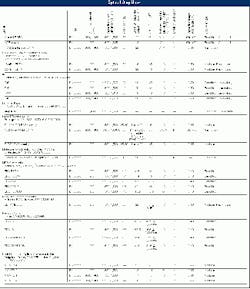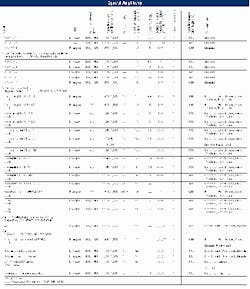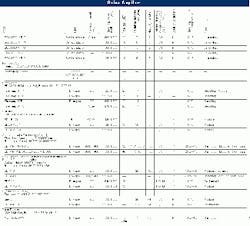Specialized optical amplifiers no longer mere laboratory curiosities
By MEGHAN FULLER
About the only point on which people agree regarding the optical-amplifier market is that it is entering a new phase. Conventional or C-band erbium-doped fiber amplifiers (EDFAs) still compose about 95% of the total market, but they are no longer the only amplifiers available. Once mere laboratory curiosities, L- and S-band EDFAs, Raman amplifiers, erbium-doped waveguide amplifiers (EDWAs), and semiconductor optical amplifiers (SOAs) are now or will soon be commercially available. Granted, some of these amplifiers may find more applications than others, but they are all part of a trend toward increased specialization. Today's optical amplifiers are merely trying to keep pace with today's networks-and that's not an easy task.
The function of an optical amplifier is simple: It boosts the power of a photonic network. They facilitate long-distance transmission and eliminate the need for optical-electrical-optical conversion at every amplifier site.
In today's networks, four or five optically amplified segments may be strung together-over the course of 300 to 500 mi-before the signal requires electronic regeneration. The occasional electrical conversion is still necessary because optical amplifiers are not equipped to clean the signal as it passes through. When a signal is optically amplified, so too is its distortion.
Several vendors, including Southampton Photonics, are developing optical amplifiers with intermediate signal-processing capabilities, but these have yet to enter the mainstream.
The majority of today's amplifiers are EDFAs that operate in the C-band, which spans the 1,530- to 1,560-nm window. EDFAs feature a completely passive transfer of energy. The photons or transmission signals enter the amplifier on special fiber that has been doped or impregnated with the rare earth element, erbium. When the photons come into contact with the erbium, they experience an instant and tremendous surge in power, but immediately begin to deteriorate again. The photons are then hit from behind with a pump laser, which pushes them out onto the outgoing fiber. The signal remains at its high level of energy for another 80 to 100 km or until it reaches the next amplifier.
Equipment developers have been looking to tweak the design of the EDFA to increase bandwidth and add more channels to the network, thus satisfying carriers' demands. One alternative is to use a standard C-band EDFA but pack the wavelengths closer together. The other feasible option-which is becoming increasingly more popular-is to explore other wavelength regions, particularly the Long or L-band region.
The L-band window runs from roughly 1,570 to 1,620 nm. When used in conjunction with the C-band, the L-band effectively doubles the spectrum without altering the channel spacing. According to Kathy Szelag, vice president of marketing at Lucent Technologies (Murray Hill, NJ), users are interested in L-band amplifiers not only as a means to increase bandwidth but also because the colors of light in the L-band work better on special kinds of fiber, particularly dispersion-shifted fiber.
The use of amplifiers in the Short or S-band, which runs from 1,450 to 1,520 nm, may also occur in the near future. Traditional EDFAs are inadequate here, however, as the erbium does not have gain in this window. Some vendors, including IPG Photonics, are exploring the possibility of using thullium, an ion much like erbium but with gain in the S-band.
"My guess is that something like [S-band amplification] won't hit until 2002 or 2003," says Bob Shine, director of marketing at Wavesplitter Technologies (Fremont, CA). "There is enough to keep people busy in the next couple of years with the C- and L-band. However," he adds, "things will continue."
And continue they have. The hottest slice of the market is Raman amplification, which Strategies Unlimited (Mountain View, CA) predicts will reach $3.5 billion by 2004. Given Raman's newness to the market, this number speaks volumes.
"Now that people are talking about the benefit of going very-long or ultra-long haul, Raman amplification is the hot thing," asserts David Ronald, senior optical-product manager at Ditech Communications Corp. (Mountain View, CA). "Now when you go to shows like OFC, all you hear about is Raman, Raman, Raman. It's quite amazing actually."
A major weakness of the EDFA is its poor signal-to-noise ratio-but this can be mitigated through Raman amplification. The two technologies are not competing, but are used in conjunction with one another. EDFAs provide a cost-effective transfer of energy, but they can only boost signals to a certain level before nonlinearities begin to develop in the fiber. The Raman amplifier acts almost like a preamplifier and provides a better signal-to-noise ratio.
"The EDFA is like sitting in the back of a horse and pushing it," explains Szelag, "and the Raman amplifier is like standing in front of a horse with a carrot, pulling it toward you."
Raman amplification employs very-high-power laser energy-750 mW-to amplify over a long distance. The Raman amplifier pumps backward toward the previous amplifier. Unlike EDFAs, which provide a lumped amplification, Raman amplifiers provide amplification over the whole length of the fiber, particularly in the last 20 to 30 km.
While vendors are understandably enthusiastic about the future of the optical-amplifier market, others are more cautious. Stephen Montgomery, president of the market-research firm ElectroniCast (San Mateo, CA), believes that over time the deployment of optical amplifiers will decrease rather than increase, because many of the long-haul submarine and terrestrial networks in which they are primarily used have already been built. Some carriers are in the process of doing overbuilds, but the bulk of the construction is completed.
"The decline in terms of number of units and the decline in terms of value isn't happening yet," he explains, "because some of the larger countries like China and others are going to be putting in fiber optics for the next 10 years." ElectroniCast predicts the market will not drop off sharply but will slow down gradually beginning in 2005-at least in the long-haul space.
"Are there other reasons, though, why you would need an optical amplifier besides just long distance?" Montgomery asks. The answer, he says, is yes-optical amplifiers are seeing increased deployments in both the metro and the access spaces.
Metro links from one central office (CO) to another have gotten longer. Link lengths that were once 40 to 50 km are now well over 100 km. In addition, COs are becoming more efficient and equipment footprints smaller, which may render some COs unnecessary. Interexchange carriers are entering the local-area market and eventually, they will bypass the COs entirely, which will further lengthen interoffice links and necessitate the use of optical amplifiers.
In the access space, optical amplifiers may be used to expand bandwidth. However, warns Montgomery, there are other ways to increase bandwidth in this space, and they may prove less expensive than optical amplification. One is to increase the transfer rate of the transmitter itself, to upgrade from OC-12 to OC-48 or even OC-192. The other option is to put in more fiber, which is feasible in access links of a mile or less where there is an existing empty conduit or underground pipe. Montgomery believes these options will be implemented over optical amplification for at least the next five years or so.
"Our DWDM numbers in the access are not lousy," he says, "but it's not going to be booming either."
Tom Hausken, senior analyst in optical communications at Strategies Unlimited, agrees that the overall market is not necessarily on the decline; rather, he sees it as an evolution. "The whole amplifier sector is actually evolving to a more complex level," he says. "We see the market growing."
Two lower-cost amplifiers, EDWAs and SOAs may provide a viable alternative to higher-profile amplifiers. The first, the EDWA, is commercially available from just two vendors, Teem Photonics and MOEC, according to Hausken. The physical concept of an EDWA is the same as an EDFA; the medium is different. Instead of using a doped fiber, an EDWA employs a doped waveguide in a silica glass substrate, which can be made much more cheaply than an EDFA.
The SOA is a semiconductor chip designed like a laser, but instead of amplifying light to the point of lasing, it is faceted on both ends and used as a gain medium. Once perfected, the SOA could have real cost-saving potential. Some companies are arguing that by this summer, the cost of an SOA will be down to $1,000 per amplifier in OEM quantities.
According to Paul Polishuk, market analyst with Information Gatekeepers (Boston), there is much greater interest in SOAs outside the United States, particularly in Europe where they are actually used in long-distance networks. In the United States, however, SOAs should see the bulk of their deployment in the access segment, where low-power, less-expensive amplifiers are adequate.
Despite projections to the contrary, many remain optimistic about the future of the optical-amplifier market, including Hausken. "I understand why people might think the market might be peaking," he says, "but what we see are added features, which increase the price, and new applications, which increase the volume. The networks are changing, but they will still need amplifiers as much as, if not more than, before."-
-
-
-
